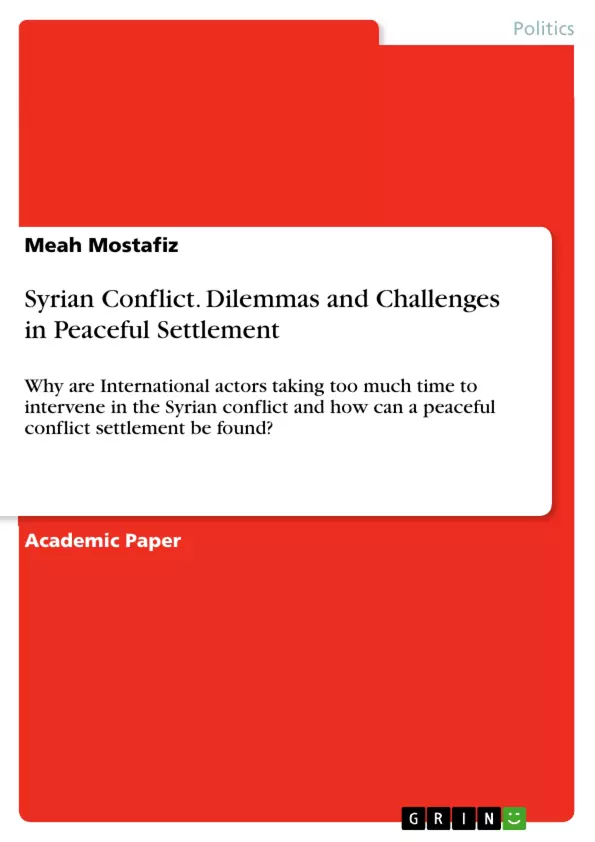With too many International and Regional interest groups involved in the Syrian war, this paper analyses why the Syrian conflict is so complex, why the international effort to peace negotiations failed. At the end it tries to find options for a peaceful settlement.
Inhaltsverzeichnis (Table of Contents)
- Introduction
- Research Question
- Hypothesis
- Part one: Analyzing the Syrian conflict
- Syria Country profile
- How and why the Syrian conflict began
- Opposition rebel groups
- The Regional Actors and their interests
- Global actors and their interests
- Who is supplying weapons in Syrian Conflict?
- Part two: Why is the Syrian conflict taking too long to resolve?
- The R2P: the complexity and challenges in Intervention
- A common unified opposition is required
- Spoilers
- Fear of Peace
- G8 leaders with no joint declaration
- Obama administration's new move
- Part three - Recommendations: How a peaceful conflict settlement can be achieved?
- Managing Syrian conflict
- Why United Nations Mediation attempt towards Syrian Conflict failed?
- United Nations Actions in Syria as mediator
- A peaceful settlement approach offered by the International Peace Initiative for Syria
- Declaring Syria as a threat for peace
Zielsetzung und Themenschwerpunkte (Objectives and Key Themes)
This paper examines the complexities of the Syrian conflict, analyzing the factors contributing to its prolonged duration and exploring potential pathways towards a peaceful resolution. It aims to identify the key interests of international and regional actors involved, understand the challenges to intervention and peace negotiations, and propose practical solutions for managing and resolving the conflict.
- The intricate web of interests and motivations among regional and international actors.
- The impact of internal divisions and a lack of unified opposition on the conflict's duration.
- The challenges and complexities of international intervention, particularly in light of the Responsibility to Protect (R2P) principle.
- The role of fear of peace and the potential ramifications for key players in a peaceful settlement.
- Potential avenues for a peaceful conflict settlement through mediation, international collaboration, and a focus on managing the conflict.
Zusammenfassung der Kapitel (Chapter Summaries)
The first part of the paper presents a detailed profile of Syria, outlining its history, political system, demographics, and key features. It then delves into the origins of the Syrian conflict, highlighting the catalyst for the initial unrest and the role of the Arab Spring. The chapter further analyzes the composition of opposition groups, emphasizing the diversity of their goals and alliances.
Part two explores the reasons for the protracted nature of the Syrian conflict. It investigates the challenges of international intervention and the complexities of the Responsibility to Protect (R2P) principle. The chapter also examines the significance of a unified opposition and the role of spoilers in obstructing peaceful resolution. Further, it analyzes the impact of a "fear of peace" among key actors.
Schlüsselwörter (Keywords)
Syrian conflict, peace negotiations, international actors, regional interests, Responsibility to Protect (R2P), unified opposition, fear of peace, conflict management, mediation, peaceful settlement, international collaboration.
- Citation du texte
- Meah Mostafiz (Auteur), 2013, Syrian Conflict. Dilemmas and Challenges in Peaceful Settlement, Munich, GRIN Verlag, https://www.grin.com/document/276392



